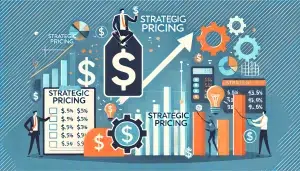Setting the correct product price is crucial for maintaining competitiveness and profitability. Price testing is an essential strategy that allows businesses to explore various pricing options without alienating customers.
This process involves assessing the impact of different price levels on consumer behavior and sales, helping companies to make informed decisions.
As the market evolves, so should your pricing strategies to adapt to changes such as new competition, cost fluctuations, and shifts in consumer demand.
Why Consider Price Testing?
Effective price testing in e-commerce is crucial as it provides a structured approach to understanding how pricing strategies can impact your sales and brand reputation.
By carefully adjusting prices, businesses can stay competitive and aligned with ongoing market changes and consumer expectations.
Adapting to Market Changes
The dynamic nature of e-commerce means that factors such as competitor pricing, fluctuations in production costs, and broader economic conditions, like inflation, can rapidly change the ideal pricing landscape for your products.
For instance, if a new competitor enters the market with lower prices, it might be necessary to reassess your pricing strategy to remain competitive.
Similarly, changes in the cost of materials or labor can affect your cost structure, necessitating adjustments to maintain or improve margins.
Regular price testing allows businesses to stay adaptive and responsive, ensuring they are not left behind as the market evolves.
Understanding the Impact on Sales and Brand
The price is a critical factor that directly influences consumer purchasing decisions and perceptions of a brand. By engaging in systematic price testing, companies can find the optimal balance that maximizes sales volume and profit margins.
For example, premium brands often test higher price points to confirm that their market positioning aligns with consumer expectations of luxury and quality.
Conversely, more budget-conscious brands might test lower prices to attract a larger customer base.
Through such testing, businesses can also gauge how sensitive their customers are to price changes, which is invaluable for developing long-term pricing strategies that foster customer loyalty and brand integrity.
How to Conduct Effective Price Testing
Effective price testing is pivotal for any e-commerce business aiming to refine its pricing strategy without alienating customers.
This process involves adjusting prices and analyzing the impact on consumer behavior and sales performance.
1. Set Clear Objectives
Establishing clear objectives is the foundation of successful price testing. Identify why you want to alter your prices—whether to increase your profit margins, cope with rising costs, or improve customer service like faster shipping.
For example, if a business aims to enhance service speed, they might consider if a slight price increase could subsidize the cost for quicker delivery options. Companies should set specific, measurable goals for their price testing to evaluate its impact accurately and make informed decisions based on actual outcomes.
2. Select Appropriate Products for Testing
Choosing the right products for price testing involves strategic selection to minimize risk and maximize informative feedback. Start with products that, while integral to your inventory, do not solely sustain your revenue stream. This could include items with stable sales but less sensitivity to price fluctuations.
By testing price changes on these products first, you can gather valuable insights into customer reactions without jeopardizing your main revenue drivers. For instance, a business might test price adjustments on a secondary line of accessories before implementing changes on their flagship products.
3. Implement Gradual Adjustments
Gradual adjustments allow businesses to test the waters with minimal risk. Incremental price changes help observe how each adjustment influences customer behavior and sales without the shock that sudden significant increases might cause. This approach also provides customers time to adjust to new pricing, reducing the risk of severe backlash.
For instance, a company might increase the price of a product by a small percentage and monitor sales and feedback over a few months before deciding on further increases or reverting to original prices.
4. Utilize a Mix of Pricing Strategies
A multifaceted approach to pricing allows businesses to adapt to various factors affecting their market and product appeal:
- Cost-Plus Pricing: This straightforward approach involves adding a standard markup to the cost of production. It’s predictable and ensures coverage of costs but might not always align with market or consumer price expectations.
- Competitor-Based Pricing: Monitoring competitors’ pricing can guide your pricing strategy. Tools like Pricefy are instrumental in this approach, offering real-time data to ensure your pricing remains competitive yet profitable.
- Dynamic Pricing: Adapting prices based on real-time market demand and competitor prices can help capture maximum revenue during peak demand periods and remain competitive when demand wanes.
- Value-Based Pricing: This strategy involves setting prices primarily on the perceived value to the customer. Collecting customer feedback through surveys or analyzing purchasing behaviors can provide insights into how much value customers place on your products.
5. Measure and Analyze Results
Constant monitoring and analysis are vital to understanding the impact of your price testing. Utilizing analytics tools like Pricefy to track changes in sales, customer engagement, and profitability after price adjustments helps businesses determine the success of their pricing strategies. This continuous feedback loop allows real-time adjustments and helps refine future pricing tactics.
For example, if an increase in price leads to a disproportionate drop in sales, it may indicate that the new price point is above what customers perceive as fair value, prompting a reassessment of the pricing strategy.
Common Pitfalls to Avoid in Price Testing
Navigating the complexities of price testing involves knowing potential pitfalls that can undermine your efforts and negatively impact your business. To optimize your pricing strategies effectively, it’s essential to avoid common mistakes that could lead to undesired outcomes.
- Overly Aggressive Cuts: Drastically reducing prices to increase sales volume might seem tempting, but it can severely impact your profit margins and dilute your brand’s perceived value. Instead, consider limited-time offers or targeted promotions that create urgency without permanently establishing lower price expectations.
- Inconsistent Testing Methods: Using inconsistent methods for A/B price testing can create confusion and mistrust among customers, who may feel unfairly treated. To maintain trust, ensure that your testing methods are transparent and applied uniformly across similar customer segments, perhaps by segmenting users anonymously and equally during tests.
- Ignoring Customer Feedback: Customer feedback is critical to successful price testing. Neglecting it can lead to misaligned pricing strategies that don’t meet market needs. Regularly collect and analyze customer feedback through surveys, social media interactions, and review analyses to adjust prices that genuinely reflect the value perceived by your customers.
Conclusion: Navigating Price Testing with Confidence
Price testing is more than just finding the correct number; it’s about enhancing your brand’s value proposition in the eyes of consumers. With thoughtful strategies and tools like Pricefy, businesses can test prices effectively, ensuring they remain competitive and profitable in e-commerce. Successful price testing combines analytics, customer insight, and strategic pricing models.
FAQ
1. What is price testing, and why is it important for e-commerce businesses?
Price testing involves experimenting with different pricing levels to determine the optimal price point that maximizes sales and profits without alienating customers. It’s crucial for e-commerce businesses because it helps them stay competitive in a constantly changing market, ensures alignment with consumer price perceptions, and can significantly impact profitability. Companies can make informed decisions that support their growth and strategic goals by effectively testing prices.
2. How do I choose which products to use for price testing?
Selecting products for price testing should be strategic; consider using products that have stable but not critical sales contributions to your overall revenue. This minimizes risk while still providing meaningful data. You might start with products that are mid-range in popularity—neither bestsellers nor poor performers. This approach helps you understand customer sensitivity to price changes without risking significant impacts on your primary revenue streams.
3. What are some effective strategies for implementing price changes based on testingresults?
Once you’ve gathered data from your price testing, the following steps involve careful implementation based on insights gained. Here are some strategies:
- Gradual Implementation: If the testing indicates a price increase is feasible, consider implementing it gradually to avoid shocking customers and monitor ongoing consumer response.
- Segmented Pricing: Use customer segmentation to apply prices based on customer profiles and purchasing behaviors, ensuring that price changes are optimized for different market segments.
- Promotional Pricing: Introduce new prices as part of promotional campaigns to gauge customer reactions without fully committing to a change. This can also help boost the volume and visibility of the tested products.
These strategies enable businesses to refine their pricing tactics incrementally, enhancing their adaptability and effectiveness in the competitive e-commerce landscape.




